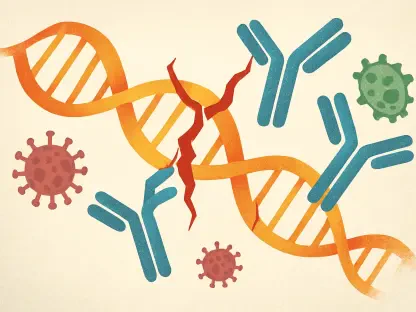In the complex world of oncology, multiple myeloma (MM) stands as a formidable challenge, affecting thousands across Europe with its intricate disease mechanisms and diverse patient needs. As the second most common blood cancer after non-Hodgkin lymphoma, MM impacts around 46,000 new individuals annually in Europe, a statistic that underscores the urgent need for innovative therapies. The treatment landscape has evolved significantly, yet gaps remain in achieving sustained remission for varied patient profiles. This report delves into the transformative role of Sarclisa (isatuximab), a targeted therapy by Sanofi, which has recently gained expanded approval from the European Commission (EC), potentially reshaping the standard of care for MM patients.
The current state of the MM treatment industry reflects a dynamic push toward personalized medicine, with an emphasis on therapies that address specific disease markers. While traditional approaches like chemotherapy and stem cell transplants remain relevant, the integration of novel agents offers renewed hope. Sarclisa’s latest milestone positions it at the forefront of this shift, promising deeper responses and broader accessibility. This analysis explores how this development aligns with industry trends and what it means for the future of MM management.
Understanding Multiple Myeloma and the Treatment Landscape
Multiple myeloma represents a significant burden within hematologic malignancies, characterized by the uncontrolled growth of plasma cells in the bone marrow, leading to complications like bone damage and immune suppression. With a substantial number of new diagnoses each year in Europe, the disease demands a multifaceted approach to treatment that can cater to diverse patient conditions, including age and eligibility for intensive procedures like autologous stem cell transplant. The complexity of MM lies in its relapsing nature, often requiring multiple lines of therapy over a patient’s lifetime.
The existing treatment framework encompasses a range of options, from immunomodulatory drugs to proteasome inhibitors, yet challenges persist in achieving long-term control across all patient subgroups. Transplant-eligible patients often undergo induction therapy followed by high-dose chemotherapy and transplant, while ineligible patients rely on less intensive regimens, highlighting the need for adaptable solutions. Variability in response rates and the risk of relapse underscore the importance of innovation in this space, as many patients still face unmet needs despite advances.
Sanofi emerges as a key player in this evolving landscape, driving progress through targeted therapies like Sarclisa, which focuses on the CD38 protein on MM cells to elicit anti-tumor effects. The introduction of such therapies marks a pivotal shift toward precision in MM care, offering tailored options that improve outcomes. This sets the stage for examining how Sarclisa’s expanded indications address critical gaps and redefine therapeutic standards in the field.
Sarclisa’s Expanded Role in MM Therapy
Clinical Breakthroughs and EC Approval
Sarclisa has achieved a landmark advancement with the European Commission’s approval for a new indication, combining it with bortezomib, lenalidomide, and dexamethasone (VRd) as an induction treatment for newly diagnosed MM patients eligible for autologous stem cell transplant. This decision broadens the drug’s applicability, building on its prior authorizations in the EU for other MM scenarios, including the same VRd regimen for transplant-ineligible patients. Such comprehensive coverage ensures that Sarclisa can be utilized across all lines of therapy, a significant step in standardizing access to cutting-edge care.
This regulatory milestone reflects a growing recognition of Sarclisa’s potential to transform treatment protocols for a wide array of MM patients. By addressing both transplant-eligible and ineligible populations, the therapy offers a unified approach that simplifies clinical decision-making. The approval enhances the therapeutic arsenal available to healthcare providers, ensuring more patients can benefit from innovative options at critical stages of their disease journey.
The broader impact of this development lies in its ability to democratize access to advanced MM treatments across diverse European healthcare systems. Patients now have an opportunity to engage with a therapy that aligns with their specific clinical needs, regardless of their suitability for intensive procedures. Sanofi’s strategic focus on expanding Sarclisa’s indications underscores a commitment to inclusivity in oncology care, paving the way for improved survival and quality of life.
Evidence from the GMMG-HD7 Study
Underpinning Sarclisa’s expanded approval is compelling data from the phase 3 GMMG-HD7 study, conducted by the German-speaking Myeloma Multicenter Group. The trial’s first part revealed a statistically significant enhancement in minimal residual disease (MRD) negativity at the conclusion of an 18-week induction period among patients treated with Sarclisa-VRd. This metric is crucial, as it indicates the absence of detectable cancer cells, a strong predictor of sustained remission.
Further insights from the study highlight that 53.1% of patients on the Sarclisa-VRd regimen achieved sustained MRD negativity from post-induction through post-transplant phases, compared to just 38% in the control arm. This marked difference illustrates the therapy’s efficacy in reducing residual disease burden, a factor closely linked to improved progression-free survival. Such results provide a robust evidence base for integrating Sarclisa into frontline treatment protocols.
The significance of MRD negativity extends beyond immediate outcomes, serving as a beacon for long-term disease management in MM. By achieving deeper responses early in the treatment course, Sarclisa offers a pathway to delay relapse and enhance patient prognosis. These findings position the therapy as a game-changer, reinforcing its value in clinical settings and guiding future research into optimizing induction strategies.
Challenges in Multiple Myeloma Treatment
Treating multiple myeloma remains a complex endeavor due to the disease’s heterogeneous nature, where patient responses vary widely based on genetic profiles and comorbidities. The relapsing-remitting pattern of MM often necessitates sequential therapies, complicating long-term management and increasing the risk of treatment resistance. Addressing these intricacies requires therapies that are both versatile and effective across different disease stages and patient demographics.
Barriers to adopting novel treatments like Sarclisa also pose significant hurdles, particularly in terms of cost and disparities within European healthcare systems. High expenses associated with advanced therapies can limit accessibility, especially in regions with constrained budgets or fragmented reimbursement models. Logistical challenges, such as ensuring consistent drug supply and specialized administration, further complicate widespread implementation in diverse settings.
To mitigate these issues, strategies must focus on enhancing affordability and streamlining distribution channels. Sanofi’s dedication to expanding Sarclisa’s clinical applications includes efforts to collaborate with policymakers and healthcare providers to improve access. By advocating for equitable pricing models and supporting patient assistance programs, there is potential to bridge gaps, ensuring that innovative treatments reach those in greatest need across the continent.
Regulatory Milestones and Their Impact
The European Commission’s approval of Sarclisa for newly diagnosed MM patients eligible for transplant signifies a critical endorsement of its clinical efficacy and safety profile. This regulatory achievement highlights a rigorous evaluation process that prioritizes patient benefit, reflecting confidence in the therapy’s ability to address unmet needs. Such decisions play a vital role in shaping the therapeutic landscape, setting benchmarks for future drug approvals in oncology.
Broader trends in regulatory frameworks for cancer treatments emphasize a shift toward innovative and personalized approaches, with agencies demanding robust data on safety and effectiveness. The focus on therapies that target specific molecular pathways, like Sarclisa’s action on CD38, aligns with this direction, encouraging the development of precision medicine. Regulatory bodies are increasingly facilitating faster pathways for drugs that demonstrate significant clinical impact, expediting patient access to life-changing options.
These regulatory milestones influence clinical practices by establishing new standards of care and encouraging adoption among healthcare professionals. In the European Union, approvals like Sarclisa’s foster a harmonized approach to MM treatment, guiding physicians in integrating advanced therapies into routine practice. This dynamic ultimately reshapes patient management, ensuring that regulatory progress translates into tangible improvements at the bedside.
Future Directions for Sarclisa and MM Care
Looking ahead, Sarclisa holds immense potential to further redefine MM treatment through ongoing research into additional indications and combination regimens. Exploring its synergy with emerging agents could unlock new therapeutic avenues, enhancing efficacy across varied patient cohorts. Sanofi’s investment in clinical trials from the current year through 2027 aims to uncover novel applications, potentially expanding Sarclisa’s role in both early and relapsed settings.
Emerging trends in oncology, such as the integration of biomarkers like MRD into treatment planning, point toward a future where therapy is increasingly tailored to individual disease characteristics. The growing emphasis on targeted therapies reflects a broader industry shift, prioritizing precision over one-size-fits-all approaches. Sarclisa’s alignment with this paradigm positions it as a leader in driving personalized care for MM patients.
External factors, including global health policies and economic conditions, will also shape the trajectory of MM therapies. Fluctuations in healthcare funding and international collaboration could impact drug development and availability. Navigating these challenges will require adaptive strategies to ensure that innovations like Sarclisa remain accessible, sustaining momentum in the quest to improve outcomes for MM patients across Europe and beyond.
Reflecting on Progress and Next Steps
Looking back, the expanded approval of Sarclisa by the European Commission marked a defining moment in multiple myeloma care, offering a powerful tool to achieve deeper disease control. The clinical evidence from the GMMG-HD7 study underscored its impact, with significant improvements in minimal residual disease negativity paving the way for better patient outcomes. Sanofi’s relentless pursuit of innovation in this space set a precedent for addressing complex challenges in oncology.
As the industry moved forward, the focus shifted to actionable strategies, such as forging partnerships to enhance affordability and access to Sarclisa across diverse European regions. Stakeholders were encouraged to prioritize education for healthcare providers, ensuring seamless integration of this therapy into clinical workflows. These steps aimed to maximize the reach of advanced treatments, breaking down barriers for patients in need.
Beyond immediate implementation, the horizon called for sustained research into optimizing combination therapies and identifying biomarkers that could further refine treatment selection. The journey of transforming MM management demanded a collective effort to adapt to evolving scientific and economic landscapes. By maintaining this momentum, the oncology community could build on past successes, ensuring that every patient had the chance to benefit from groundbreaking care.









